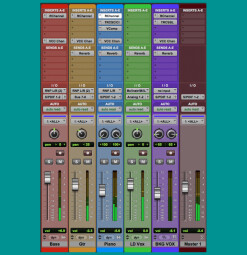From what we've seen up to now, we could deduce the following: Mixing can be assimilated to assembling pieces of a 4D puzzle according to a given tempo to form a sonic moving picture. But what can we actually learn from looking at it this way?
Little by little
Well, first off, try to recall when you were a kid and you got your first puzzle ever. Was it a 20,000-piece one? Certainly not. Learning how to play this game of patience begins with a limited number of elements. And the same goes for mixing. It’s better to cut your teeth on an easy track. For example, a song with one guitar, a piano, vocals and, eventually, backing vocals. Or, if you are more into electronic music, a minimalist kick/snare beat, a synth bass line, a pad and a lead for the melody. Anything with five or six different elements, tops.
Achieving something coherent and interesting with so few things is already a good challenge, but it’s much more feasible and, thus, educational than approaching a song with 17 guitars, a bass, drums, two rappers, a singer, two backing vocals, and a symphonic orchestra. Furthermore, from a psychological point of view, it’s easier to succeed at it, making it a gratifying experience that will encourage you to keep on the same path. The idea is to progressively increase the complexity, like with anything you learn!
One vision!
The second lesson we can learn from this metaphor is even more important. Would you consider trying to a assemble a puzzle without having the slightest idea of what the image looks like? Do you think David Fincher starts filming a movie without a script or storyboard? One more time, the answer is: Obviously not. The moral of the story? The sound engineer must have the clearest possible idea of what he or she wants to achieve before starting any mix. In short, to meet a goal you’ll need to set it first, otherwise you will be wandering erratically.
All that sounds nice, but how do you learn to create this vision of a mix? As is often the case in the art domain, the best thing you can do is to study and get inspired by the great masters on the subject. With this in mind, I recommend you to read one of our previous articles that dealt with how to analyze a mix. Once you’ve dissected a couple of songs, you should be more or less ready to figure out how you want things to go when it comes to mixing a particular song.
In theory, you already know the music, whether it’s because you wrote it, played it, recorded it, or all of the above. In short, you know it well enough to be able to take a sheet of paper and lay down a picture of the mix without the need of listening to it again, for the time being. Note down the ideas you have about how to place things, the instruments that you think are the most important at any given moment, in which frequency zones you would like to “frame” them, how everything will evolve, depending on the different parts of the song, etc. To sum it up, you need to describe in writing, as precisely as possible, the sound you have in your head. It is this sonic picture of the song that will make the mix yours. You will infuse your personality into it, which will make the whole difference between your mix and the same song mixed by someone else, so let it all hang out!
After all, there is no secret, like everything in life, you need to take the plunge. Mixing is taking decisions and assuming the responsibility for them. So, set a goal and don’t give up until you have achieved it. It doesn’t matter if your vision is good or bad, there is ultimately no “definitive answer” to that sort of questioning. What’s important is that you realize that vision. It makes no sense to pull your hair out and put pressure on yourself. Even more so considering that, at this stage, nothing is definitive…
In the next installment, we will see how to confront your vision with the reality of the recordings, in order to fine-tune the former a bit and, finally, start mixing.

